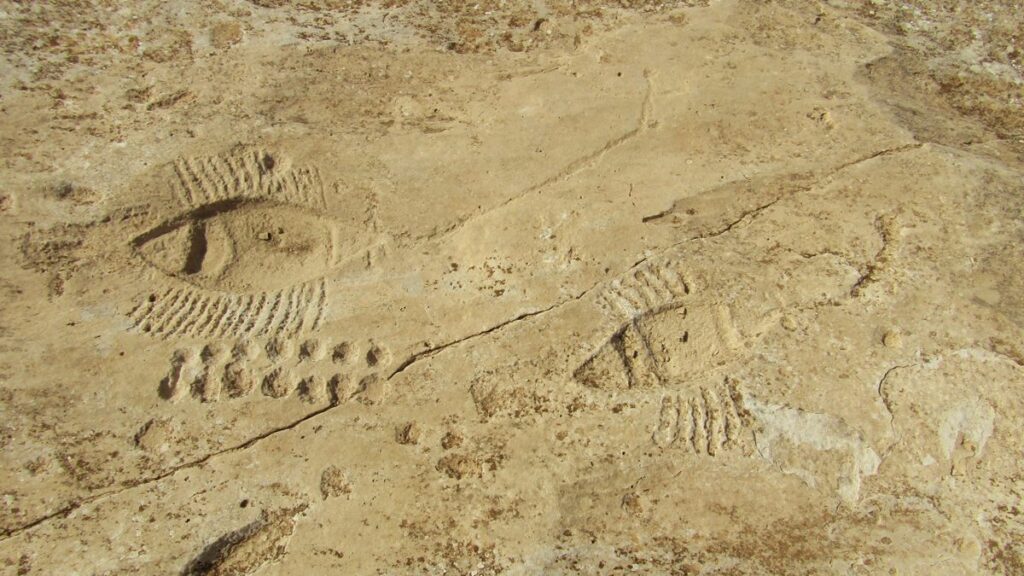Located in the northeast of Qatar, Al Jassasiya is the most impressive of dozens of rock carvings found in Qatar. It consists of a total of 874 rock carvings, thought to be the oldest surviving “petroglyphs” (writing or figures carved into rocks) from Neolithic times.
This bizarre rock art is scattered across the Al Jassasiya sand dunes in Qatar and contains some 900 carvings arranged in neat rows. Experts are still trying to figure out exactly when these ancient carvings originated and why they are there.
The majority of the artwork is composed of cup forms, mostly hidden from above and arranged in a straight line, featuring rows, rosettes, and representations of sailing stores. Two parallel rows of seven holes, which some think were used to play the well-known board game mancala, are the most remarkable pattern. Mancala is a game played by two opponents by dropping an odd and even number of small stones into holes. The game dates back to the 700s AD in East Africa.
Other scientists, however, dispute this theory, claiming that some of the holes at Al Jassasiya are too small to hold stones and are located on slopes, making them impractical for play.
Some also believe that these cup forms were used for divination, or to separate and store pearls, or to calculate time and tides.
Centuries ago, people carved symbols and objects they saw into a series of low-lying rock formations made of limestone. Qatar is home to 12 important petroglyph sites, most of them along the coast, but some carvings overlook the famous coastline of the capital Doha.
Al Jassasiya was discovered north of the city in 1957 and cataloged 16 years later by archaeologists with photographs and drawings. Located in a remote corner of Qatar’s north-east coast, this eerie site is known as the country’s largest and most important rock art site.
While rock art is common throughout the Arabian Peninsula, experts say that some of the carvings at this site in particular – such as the bird’s-eye view of ships – cannot be found anywhere else.
“These carvings represent a high degree of creativity and observation skills [on the part of] the artists who made them. Also abstract thinking, as they were not able to see the dhow (a traditional ship) from above. In my opinion, they might have a ritual meaning and function which is very old so that it cannot be explained ethnographically.” said Ferhan Sakal to CNN, head of excavation and site management at Qatar Museums.



Many claim that the boat carvings are among the most fascinating. (Most of the boats seen from a bird’s eye view are fish-shaped, with pointed sterns and rows of oars carved with a sharp metal tool.) They think they can illuminate important information about the types of vessels used in the thriving fishing and pearling industries at the time.
These boats also contain impressive details such as cross ribs and holes, which probably indicate how the masts and thwarts were positioned.
Experts say the position of the oars in some of the drawings is not parallel, suggesting that they were not rowing, but instead anchored off the pearl shores where divers worked.
But one can only guess about the greater number of ship carvings at Al Jassasiya compared to other similar sites on the Qatari coast. Historians say ships played a strong role in the beliefs of ancient people, who saw them as a symbolic means of passage from this world to the next.
The team said that more than one in three carvings were cup markings of different shapes and sizes, but they had no direct clue as to their age or what they meant. More research seems to be needed.
Sakal says, “There are wild hypotheses about the age, ranging from Neolithic to late Islamic times. I personally think that not all carvings were made at the same time.”
The area is open to visitors. Take the Ras Laffan exit as you go north on Al Shamal Road from Doha. After traveling on the route for 8 kilometers, turn left. This road extends for about 3 km to Al Jassasiya. You can wander among the carvings.
